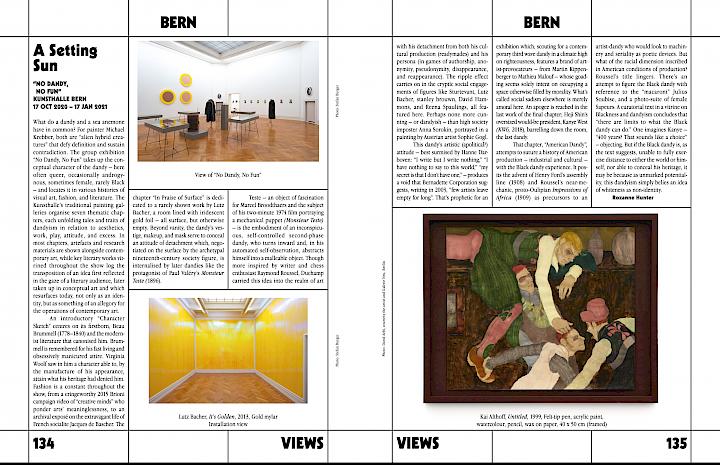A Setting Sun

What do a dandy and a sea anemone have in common? For painter Michael Krebber, both are “alien hybrid creatures” that defy definition and sustain contradiction. The group exhibition “No Dandy, No Fun” takes up the conceptual character of the dandy – here often queer, occasionally androgynous, sometimes female, rarely Black – and locates it in various histories of visual art, fashion and literature. The Kunsthalle´s traditional painting galleries organize seven thematic chapters, each unfolding tales and traits of dandyism in relation to aesthetics, work, play, attitude, and excess. In most chapters, artefacts and research materials are shown alongside contemporary art, while key literary works vitrined throughout the show log the transposition of an idea first reflected in the gaze of a literary audience, later taken up in conceptual art and which resurfaces today, not only as an identity, but as something of an allegory for the operations of contemporary art. mehr
An introductory “Character Sketch” centres on its firstborn, Beau Brummell (1778–1840) and the modernist literature that canonised him. Brummell is remembered for his fast living and obsessively manicured attire. Virginia Woolf saw in him a character able to, by the manufacture of his appearance, attain what his heritage had denied him. Fashion is a constant throughout the show, from a cringeworthy 2015 Brioni campaign video of “creative minds” who ponder arts´ meaninglessness, to an archival exposé on the extravagant life of French socialite Jacques de Bascher. The chapter “In Praise of Surface” is dedicated to a rarely shown work by Lutz Bacher, a room lined with iridescent gold foil – all surface, but otherwise empty. Beyond vanity, the dandy´s vestige, makeup, and mask serve to conceal an attitude of detachment which, negotiated on the surface by the archetypal nineteenth-century society figure, is internalized by later dandies like the protagonist of Paul Valéry´s Monsieur Teste (1896).
Teste – an object of fascination for Marcel Broodthaers and the subject of his two-minute 1974 film portraying a mechanical puppet (Monsieur Teste) – is the embodiment of an inconspicuous, self-controlled second-phase dandy, who turns inward and, in his automated self-observation, abstracts himself into a malleable object. Though more inspired by writer and chess enthusiast Raymond Roussel, Duchamp carried this idea into the realm of art with his detachment from both his cultural production (readymades) and his persona (in games of authorship, anonymity, pseudonymity, disappearance, and reappearance). The ripple effect carries on in the cryptic social engagements of figures like Sturtevant, Lutz Bacher, stanley brouwn, David Hammons, and Reena Spaulings, all featured here. Perhaps none more cunning – or dandyish – than high society imposter Anna Sorokin, portrayed in a painting by Austrian artist Sophie Gogl.
This dandy´s artistic (apolitical?) attitude – best surmised by Hanne Darboven: “I write but I write nothing,” “I have nothing to say to this world,” “my secret is that I don´t have one,” – produces a void that Bernadette Corporation suggests, writing in 2003, “few artists leave empty for a long”. That´s prophetic for an exhibition which, scouting for a contemporary third wave dandy in a climate high on righteousness, features a brand of artist-provocateurs – from Martin Kippenberger to Mathieu Malouf – whose goading seems solely intent on occupying a space otherwise filled by morality. What´s called social sadism elsewhere is merely amoral here. An apogee is reached in the last work of the final chapter; Heji Shin´s oversized would-be president, Kanye West (KW6, 2018), barrelling down the room, the last dandy.
That chapter, “American Dandy”, attempts to suture a history of American production – industrial and cultural – with the Black dandy experience. It posits the advent of Henry Ford´s assembly line (1908), and Roussel´s near-mechanic, proto-Oulipian Impressions of Africa (1909) as precursors to an artist-dandy who would look to machinery and seriality as poetic devices. But what of the racial dimension inscribed in American conditions of production? Roussel´s title lingers. There´s an attempt to figure the Black dandy with reference to the “macaroni” Julius Soubise, and a photo-suite of female Sapeurs. A curatorial text in a vitrine on Blackness and dandyism concludes that “there are limits to what the Black dandy can do.” One imagines Kanye – “400 years” That sounds like a choice” – objecting. But if the Black dandy is, as the text suggests, unable to fully exercise distance to either the world or himself, nor able to conceal his heritage, it may be because as unmarked potentiality, this dandyism simply belies an idea of whiteness as non-identity.